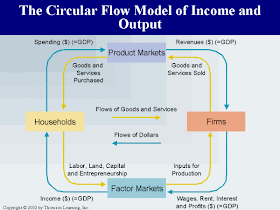To illustrate this, consider a simple economy with two countries, the United States and China. Consider two products, bicycles and airplanes.
Assume the United States has resources and technology that yield the following production possibilities frontier:
 If all U.S. resources are devoted to the production of bicycles, it can produce a maximum of 4 million bicycles per year. This is represented in the graph above by point S. Alternatively, if all U.S. resources are devoted to the production of airplanes, it can produce a maximum of 40,000 airplanes per year. This is represented in the graph by point U. If resources are evenly split between the production of bicycles and airplanes, the U.S. could produce 2 million bicycles and 20,000 airplanes at point T. By shifting the allocation of resources between the two industries, the U.S. could produce at any point on or inside its PPF.
If all U.S. resources are devoted to the production of bicycles, it can produce a maximum of 4 million bicycles per year. This is represented in the graph above by point S. Alternatively, if all U.S. resources are devoted to the production of airplanes, it can produce a maximum of 40,000 airplanes per year. This is represented in the graph by point U. If resources are evenly split between the production of bicycles and airplanes, the U.S. could produce 2 million bicycles and 20,000 airplanes at point T. By shifting the allocation of resources between the two industries, the U.S. could produce at any point on or inside its PPF.Assume China has resources and technology that yield the following production possibilities frontier:
 If all Chinese resources are devoted to the production of bicycles, it can produce a maximum of 6 million bicycles per year. This is represented in the graph above by point J. Alternatively, if all Chinese resources are devoted to the production of airplanes, it can produce a maximum of 30,000 airplanes per year. This is represented in the graph by point L. If resources are evenly split between the production of bicycles and airplanes, China could produce 3 million bicycles and 15,000 airplanes at point K. By shifting the allocation of resources between the two industries, China could produce at any point on or inside its PPF.
If all Chinese resources are devoted to the production of bicycles, it can produce a maximum of 6 million bicycles per year. This is represented in the graph above by point J. Alternatively, if all Chinese resources are devoted to the production of airplanes, it can produce a maximum of 30,000 airplanes per year. This is represented in the graph by point L. If resources are evenly split between the production of bicycles and airplanes, China could produce 3 million bicycles and 15,000 airplanes at point K. By shifting the allocation of resources between the two industries, China could produce at any point on or inside its PPF.In the absence of trade, each country is forced to consume some combination of products on or inside its production possibilities frontier (PPF). Specialization and trade can improve the standard of living in both countries by allowing each country to consume a combination of products outside its production possibilities frontier. To see this, put the PPFs for the two countries on the same graph as illustrated below:
 Suppose that in the absence of trade, China produces at point K and the U.S. produces at point T. China produces and consumes 3 million bicycles and 15,000 airplanes. The U.S. produces and consumes 2 million bicycles and 20,000 airplanes.
Suppose that in the absence of trade, China produces at point K and the U.S. produces at point T. China produces and consumes 3 million bicycles and 15,000 airplanes. The U.S. produces and consumes 2 million bicycles and 20,000 airplanes.Now consider the option of complete specialization in both countries. Suppose the U.S. completely specializes in the production of airplanes and produces at point U. This represents the U.S. producing 40,000 airplanes and zero bicycles. Suppose China completely specializes in the production of bicycles and produces at point J. This represents China producing 6 million bicycles and zero airplanes. If the U.S. then exports 20,000 airplanes to China in exchange for 3 million bicycles, both countries can then consume 3 million bicycles and 20,000 airplanes. This is represented in the graph above by point C.
The U.S. produces 40,000 airplanes, but exports 20,000 of them to China. It ends up with 20,000 airplanes. The U.S. produces no bicycles, but imports 3 million of them from China. With specialization and trade, the U.S. consumes 20,000 airplanes and 3 million bicycles.
China produces 6 million bicycles, but exports 3 million of them to the United States. It ends up with 3 million bicycles. China produces no airplanes, but imports 20,000 of them from the United States. With specialization and trade, China consumes 3 million bicycles and 20,000 airplanes.
Both countries are better off than in the absence of trade. Each country is able to consume at a point outside its production possibilities frontier (PPF).
In the absence of trade, China produced and consumed at point K. It had 3 million bicycles and 15,000 airplanes. With specialization and trade, China produces at point J, but consumes at point C. It has 3 million bicycles and 20,000 airplanes. China consumes the same number of bicycles and 5,000 additional airplanes.
In the absence of trade, the United States produced and consumed at point T. It had 2 million bicycles and 20,000 airplanes. With specialization and trade, the U.S. produces at point U, but consumes at point C. It has 3 million bicycles and 20,000 airplanes. The United States consumes an additional 1 million bicycles and the same number of airplanes.
Thus, production possibilities curves can be used to illustrate the benefits of specialization and trade.






